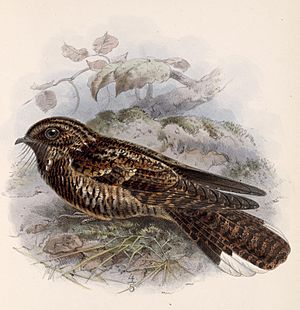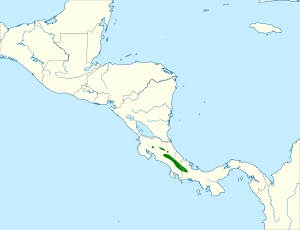Dusky nightjar facts for kids
Quick facts for kids Dusky nightjar |
|
|---|---|
 |
|
| Conservation status | |
| Scientific classification | |
| Genus: |
Antrostomus
|
| Species: |
saturatus
|
 |
|
| Synonyms | |
|
Caprimulgus saturatus |
|
The dusky nightjar or dusky whip-poor-will (Antrostomus saturatus) is a type of nightjar bird. It belongs to the Caprimulgidae family. You can find this bird in the highlands of Costa Rica and Panama.
Contents
About the Dusky Nightjar
The dusky nightjar was first given its scientific name, Antrostomus saturatus, a long time ago. It is closely related to other whip-poor-will birds, like the eastern whip-poor-will and the Mexican whip-poor-will. This bird is considered "monotypic," which means it's the only species in its group without different subspecies.
What Does a Dusky Nightjar Look Like?
The dusky nightjar is about 21 to 25 centimeters (8 to 10 inches) long. Males usually weigh around 53 grams (1.9 ounces), and females are about 51 grams (1.8 ounces).
Adult males have mostly dark, sooty-black feathers on their upper body. They also have small reddish-brown spots and stripes. Their face often has reddish-brown markings too. The middle tail feathers are dark with reddish-brown stripes, but the outer tail feathers have wide white tips. Their wings are dark with reddish-brown stripes.
The throat and chest of the male are sooty black with some white spots. A thin band of white and light brown separates these areas. Their belly is light brown with thin black stripes.
Female dusky nightjars look similar to males. However, their reddish-brown markings are larger, making them appear more reddish overall. The tips of their outer tail feathers are narrow and light brown, not wide and white like the males. Young birds are a bit lighter and more reddish than the adults.
Where Does the Dusky Nightjar Live?
The dusky nightjar lives in the high mountain areas of Costa Rica. In Panama, it can only be found on a mountain called Volcán Barú in the Chiriquí Province. These birds live at elevations from about 1,500 to 3,100 meters (4,900 to 10,200 feet) above sea level. They prefer to live at the edges and open areas of humid montane forest, rather than deep inside the forest.
Dusky Nightjar Behavior
How Does the Dusky Nightjar Find Food?
The dusky nightjar is a nocturnal bird, meaning it is active at night. It mostly hunts for food by flying out from a perch several meters (many feet) above the ground. It rarely hunts from the ground itself. Its diet mainly consists of flying insects, especially beetles and moths.
Dusky Nightjar Breeding Habits
The breeding season for the dusky nightjar seems to be from February or March into April. Only one nest has ever been described. It was a small dip in the ground, lined with grass, found among grass and ferns. This nest contained one egg.
What Does a Dusky Nightjar Sound Like?
The male dusky nightjar's song is a trilled, two-note whistle that sounds like "prurrr prureee" or "prurrrr prruwhip". They sing mostly during the breeding season, usually from a perch, and sometimes from the ground. They might even sing all night long when the moon is bright. They also have a flight call, which is described as a scratchy "wheer."
Dusky Nightjar Conservation Status
The IUCN (International Union for Conservation of Nature) has evaluated the dusky nightjar's status. They have listed it as a species of "Least Concern." This means that even though it lives in a small area, its population is estimated to be at least 20,000 adult birds and is believed to be stable. There are no immediate threats that have been identified for this bird.
Images for kids
See also
 In Spanish: Chotacabras fuliginoso para niños
In Spanish: Chotacabras fuliginoso para niños



